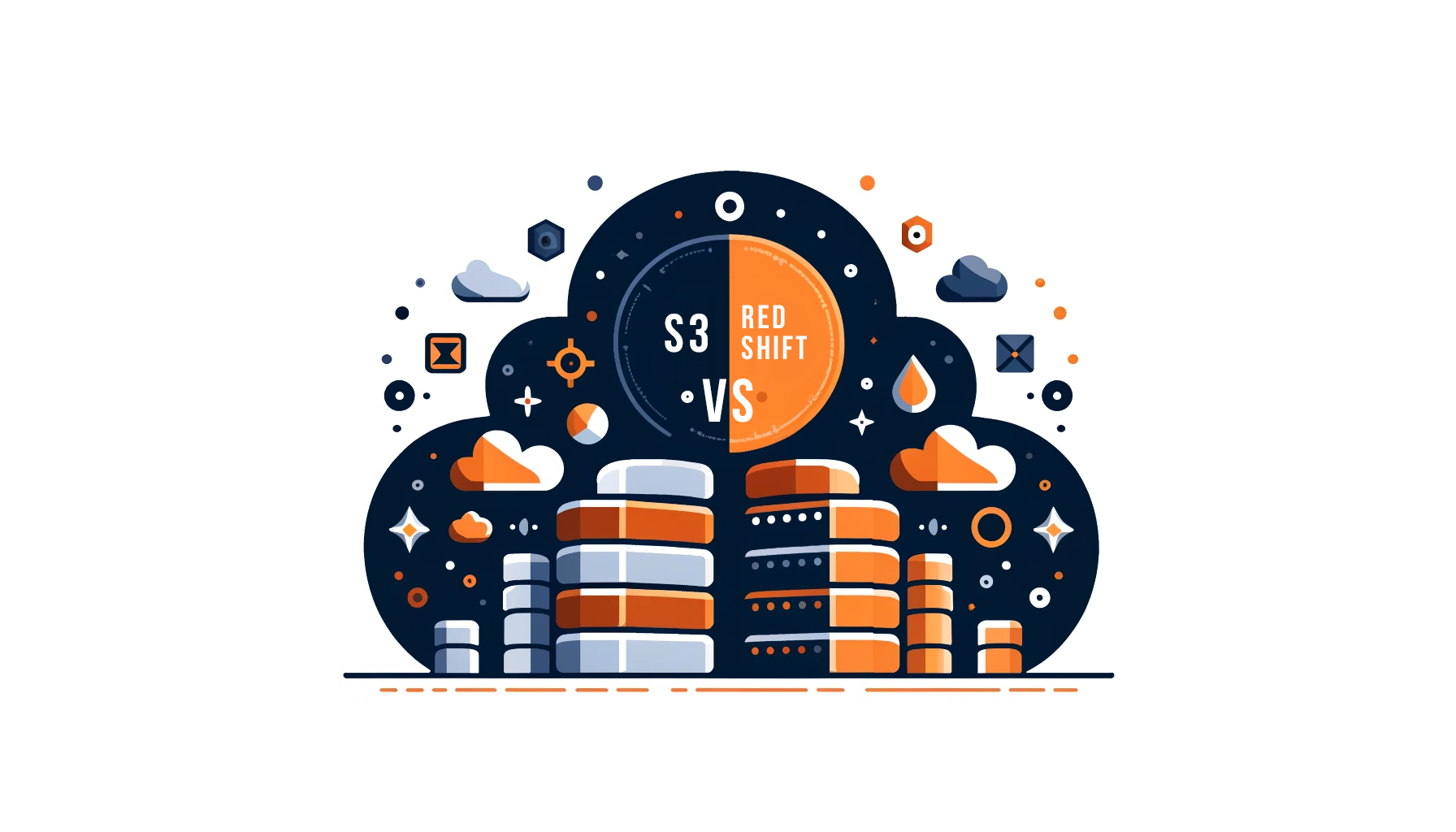
S3 vs Redshift

Introduction
Amazon Web Services (AWS) provides two strong options for storing and analyzing data in the cloud. These options are Simple Storage Service (S3) and Redshift. Both designs can handle large amounts of data, but they have different purposes. S3 vs Redshift is the main topic of this article.
It should help you determine which one is best suited for your needs. Comparison of data warehouse and storage based on main concept, purpose, and security measures.
What is Amazon S3?
To compare S3 vs Redshift we first briefly describe both of them. Amazon S3 is an object storage service that provides scalable, durable, and highly available data storage. It allows you to store and retrieve any amount of data from anywhere on the web. Many people use S3 for backup and archiving, content distribution, static website hosting, and big data analytics.
Some key features of S3 include:
- Unlimited storage capacity
- High durability (99.999999999%)
- Scalable performance
- Access control and encryption options
- Integration with other AWS services
Here’s an example of how you can create an S3 bucket using the AWS CLI:
aws s3 mb s3://my-bucket
This command creates a new bucket named “my-bucket” in S3 cloud storage service.
An Amazon S3 bucket is a container for storing objects in the Amazon Simple Storage Service (S3). It is the fundamental storage unit in S3, similar to a folder in a file system. However, unlike a folder, an S3 bucket is flat, meaning it cannot contain other buckets.
Key points about S3 buckets:
Unique naming: Each bucket must have a unique name across all of Amazon S3, not just within your AWS account.
Object storage uses buckets to store data as objects, including the data, metadata, and a unique identifier.
Unlimited objects: A single bucket can store an unlimited number of objects.
You can manage who can access a bucket and its items by using IAM policies, bucket policies, and ACLs. You can manage who has permission to access a bucket and its objects. IAM policies, bucket policies, and ACLs are tools you can use to control access.
Versioning: Buckets can store multiple versions of an object, so you can easily restore previous versions if necessary.
Static website hosting: You can configure buckets to serve static websites.
Amazon S3 is a popular choice for implementing data lakes due to its scalability, durability, and cost-effectiveness.
In an S3-based data lake, buckets are used to organize and store the data. Each bucket can represent a different data source, data type, or processing stage. For example, you might have separate buckets for raw data, processed data, and output data.
What is Amazon Redshift?
Amazon Redshift is a fully-managed, petabyte-scale cloud data warehouse service. It is designed for fast querying and analysis of large datasets using SQL. Redshift builds on top of industry-standard PostgreSQL, but optimizes for analytical processes.
Key features of Redshift include:
- Columnar storage system for efficient querying the business data
- Parallel processing architecture for data analysis
- Scalability (up to petabytes of data)
- Integration with other AWS services
- Support for standard SQL
To create a Redshift cluster, you can use the AWS Management Console or the AWS CLI. Here’s an example using the CLI:
aws redshift create-cluster --node-type dc2.large --number-of-nodes 2 --master-username admin --master-user-password Password123 --cluster-identifier mycluster
This command creates a new Redshift cluster with 2 nodes of type dc2.large. It also sets the admin username and password for the cluster. Finally, it names the cluster “mycluster.”
Comparing S3 and Redshift
Both S3 and Redshift store data for different purposes. Here are some key differences:
Data Structure
- S3 functions as an object store, storing data as objects in buckets. Each object consists of the data itself, metadata, and a unique identifier.
- Redshift is a relational database, storing data in tables with rows and columns. Data is structured and schema-defined.
Query Capabilities
- S3 does not provide built-in querying capabilities. To analyze data stored in S3, you typically use other tools like AWS Athena or Amazon EMR.
- Redshift is optimized for complex queries and aggregations using SQL. It provides fast query performance on large datasets.
Scalability
- S3 scales automatically and can store virtually unlimited amounts of data.
- Redshift can scale to petabytes of data by adding nodes to the cluster, but requires manual provisioning.
Pricing
- S3 pricing is based on the amount of data stored, requests made, and data transfer out of the region.
- Redshift pricing is based on the number and type of nodes in your cluster, charged per hour. You also pay for backup storage and data transfer.
S3 vs Redshift: Infrastructure as Code Support
Both S3 and Redshift support Infrastructure as Code (IaC) through AWS CloudFormation templates and the AWS CDK (Cloud Development Kit).
For example, you can define an S3 bucket in a CloudFormation template like this:
Resources:
MyBucket:
Type: AWS::S3::Bucket
Properties:
BucketName: my-bucketAnd a Redshift cluster like this:
Resources:
MyCluster:
Type: AWS::Redshift::Cluster
Properties:
ClusterIdentifier: mycluster
NodeType: dc2.large
NumberOfNodes: 2
MasterUsername: admin
MasterUserPassword: Password123Infrastructure as Code (IaC) is a method of managing and provisioning infrastructure through code, rather than manual processes. This approach allows you to define your AWS resources, such as servers, databases, and networking components, using code that can be easily version-controlled and repeated across different environments.
With IaC, you can make sure your infrastructure deployments are consistent and reliable. You can also easily track changes and go back to previous versions if necessary.
This method helps you automate setting up and managing your resources, which saves time and lowers the chance of mistakes. IaC is a useful tool for managing AWS resources efficiently on a large scale. It is crucial for modern cloud infrastructure management.
Security Features
Both S3 and Redshift offer robust security features to protect your data.
S3 Security
- Access Control: S3 provides fine-grained access control through IAM policies, bucket policies, and Access Control Lists (ACLs).
- Encryption: You can encrypt data at rest using server-side encryption (SSE) with Amazon S3-Managed Keys (SSE-S3), AWS KMS keys (SSE-KMS), or customer-provided keys (SSE-C). You can also use client-side encryption.
- Versioning: S3 supports versioning, allowing you to retain and restore previous versions of objects.
- MFA Delete: You can enable Multi-Factor Authentication (MFA) for object deletions, providing an extra layer of security.
Redshift Security
- Network Isolation: Redshift clusters run in a Virtual Private Cloud (VPC), providing network-level isolation.
- Encryption: Redshift offers encryption for data at rest and in transit. You can use AWS KMS keys or a hardware security module (HSM) to manage encryption keys.
- Access Control: Redshift uses IAM policies and Redshift-specific user access controls to manage permissions.
- Auditing: Redshift logs all SQL operations and connection attempts, allowing you to monitor and audit activity.
S3 and Redshift have security features such as encryption and access control. However, they also have unique security capabilities tailored to their specific purposes.
S3 vs Redshift: Conclusion
In summary, S3 and Redshift are both powerful cloud data storage solutions from AWS, but they serve different purposes. S3 is good for storing lots of unstructured data. Redshift is best for analyzing structured data with complex queries.
When deciding between S3 and Redshift, consider your specific use case, data structure, query requirements, and scalability needs. Both services offer strong security features and support Infrastructure as Code for easy provisioning and management.
Consider contacting the team at DataSunrise to learn more about securing S3 and Redshift. DataSunrise provides user-friendly and flexible tools for database security, audit, and compliance. Follow the link to schedule an online demo and see how DataSunrise can help protect your data on AWS and beyond.
